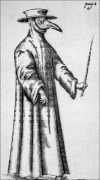Plague: from natural disease to bioterrorism
- PMID: 16200159
- PMCID: PMC1200711
- DOI: 10.1080/08998280.2005.11928049
Plague: from natural disease to bioterrorism
Abstract
Yersinia pestis is the causative agent of plague, an enzootic vectorborne disease usually infecting rodents (rats) and fleas. Humans can become infected after being bitten by fleas that have fed on infected rodents. In humans, the disease usually occurs in the form of bubonic plague. In rare cases, the infection spreads to the lungs via the bloodstream and causes secondary pneumonic plague. Person-to-person transmission has been described for pneumonic plague but is rare in primary bubonic plague. Bubonic plague can usually be treated successfully with antibiotics; however, pneumonic plague develops rapidly and carries a high fatality rate despite immediate treatment with antibiotics. Plague is also recognized as a potential agent of bioterrorism. It has been used, or considered for use, as a biologic weapon on several occasions. It is important for the medical community to be familiar with the epidemiology, diagnosis, and symptoms of plague so it can deliver an appropriate and calm response should the unthinkable happen.
Figures










References
-
- Eitzen EM, Jr, Takafuji ET. Medical Aspects of Chemical and Biological Warfare. Washington, DC: Office of the Surgeon General, Borden Institute, Walter Reed Army Medical Center; 1997. Historical overview of biological warfare. In Sidell FR, Takafuji ET, Franz DR, eds; pp. 415–423. Available at http://www.bordeninstitute.army.mil/cwbw/default_index.htm; accessed August 31, 2004.
-
- Inglesby TV, Dennis DT, Henderson DA, Bartlett JG, Ascher MS, Eitzen E, Fine AD, Friedlander AM, Hauer J, Koerner JF, Layton M, McDade J, Osterholm MT, O'Toole T, Parker G, Perl TM, Russell PK, Schoch-Spana M, Tonat K, Working Group on Civilian Biodefense Plague as a biological weapon: medical and public health management. JAMA. 2000;283:2281–2290. - PubMed
-
- Sticker G. Die Geschichte der Pest. Giessen: A Toepelmann Verlag; 1908. Abhandlungen aus der Seuchengeschichte und Seuchenlehre. Band I.
-
- Haeser H. Geschichte der epidemischen Krankheiten. Jena: G. Fischer Verlag; 1882. Lehrbuch der Geschichte der Medizin und der epidemischen Krankheiten. Band 3.
LinkOut - more resources
Full Text Sources
